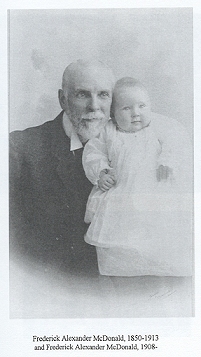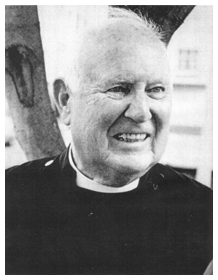


 U.S. Army Chaplain Frederick Alexander McDonald served General Omar Bradley, Commander of the Allied Forces in Europe, for the last 18 months of World War II. When Pearl Harbor was bombed in 1941, he resigned his pastorate at St. David’s Episcopal Church in Portland, Oregon, to join the cause against Hitler. McDonald, then 34, was already well-traveled, a young merchant marine when he explored Asian ports and a hiker who walked Europe’s mountain trails between the great wars. His life-long passion for religious architecture and stained-glass windows kept him curious and happy to travel. In later years he worked in Africa, Europe, Hawaii, and California, a highly regarded pastor, headmaster, administrator, and writer, and loved as a story-teller. His military record was particularly distinguished.
U.S. Army Chaplain Frederick Alexander McDonald served General Omar Bradley, Commander of the Allied Forces in Europe, for the last 18 months of World War II. When Pearl Harbor was bombed in 1941, he resigned his pastorate at St. David’s Episcopal Church in Portland, Oregon, to join the cause against Hitler. McDonald, then 34, was already well-traveled, a young merchant marine when he explored Asian ports and a hiker who walked Europe’s mountain trails between the great wars. His life-long passion for religious architecture and stained-glass windows kept him curious and happy to travel. In later years he worked in Africa, Europe, Hawaii, and California, a highly regarded pastor, headmaster, administrator, and writer, and loved as a story-teller. His military record was particularly distinguished.
Sent to Europe in 1944, CH McDonald was assigned to the 12th Army Group, led by U.S. General Omar C. Bradley. He spent 12 months close to enemy lines, driving hundreds of miles across the war-torn countryside to offer worship and pastoral care to the small army of military professionals marching the Allies into Germany. One Christmas eve he ushered General George C. Patton to a special chair in a candle-lit church in Luxembourg before conducting worship.
When the war ended, on 45-minutes notice the chaplain found himself preaching to General Bradley and the Allied commanders, his words broadcast back to the United States by NBC. He stayed on in Europe for the long months it took to return this country’s soldiers to the United States, leading a spontaneously organized “seminary,” a kind of interreligious prep school for Catholics, Jews, and Protestants who wanted to go to seminary and seek a religious vocation when they got back home.
In his war travels, Father McDonald made a habit of stopping at sanctuaries victimized by the conflict. On these visits he picked up broken fragments of stained glass from the rubble. He put the bits of colored glass in envelopes, labeled by site. These site names are a litany to the millions touched by the war – Periers, Wiesbaden, Thionville, Metz, Coutances, Verdun, Aachen, Malmedy, Cologne, Verviers, Bastogne, Dinant, Maestricht, Trier, Nuremburg, Coventry, London, and Biarritz. For 55 years the glass was kept in a cardboard box. One evening in 1999, three years before Fred McDonald died, he shared the story of the shards with astonished friends around the dinner table.
Mrs. Jean Wright, one of the friends at dinner, contacted Reflection Studios, a nationally renowned stained-glass studio across the Bay from San Francisco. A French stained-glass artist there named Armelle LeRoux met the retired chaplain, and a great friendship began. Armelle talked with Fred many times, took notes, studied each group of glass fragments, selected a team of artists to participate, and became the main artist and project leader of the McDonald Memorial Peace Windows project. The artists understood that the project had not been funded but that efforts to raise funds would go forward.
Conversations began in 1999 about the best use of the shards. A single mosaic of glass was one possibility, a window using all the shards in what probably would have been an abstract representation of Fred’s war experience. But then his remarkable memory helped take the project in a different direction. Till the end of his life, Fred’s stories captivated people. He recalled each of the visits to the damaged, destroyed cathedrals, churches, and synagogues where he picked up the bits of colored glass. He remembered his interactions with men and women struggling to survive the conflict. As he talked about those meetings, Armelle conceived of a series of windows, each with its own brief story.
The stark human reality of Fred’s memories gave an internationally distinguished stained-glass team the creative inspiration and energy for an ambitious, complex project. Through three years of conversation, the retired chaplain shared his stories and the artists responded. On March 9, 2002, Fred McDonald died and was mourned by friends and family. This year his dream will be realized, with light once again shining through these small glass fragments, capturing new images and stories about the quest for peace.
January 21, 2007, is the dedication day for the new windows. Each one, using new glass as well as the old, includes Fred’s accompanying narrative, painted or etched directly on the glass.
These brief stories become a remarkable collection, tiny tales of the toll war takes and the heroic response some are able to make. Together, the new windows resonate with the terrible cost of World War II, the courage and sacrifice of so many, and the immeasurable endurance of the human spirit in pursuing freedom, justice, and peace.
From the start, Father McDonald envisioned the new windows in a military chapel. The Main Post Chapel in the Presidio of San Francisco is an interfaith sanctuary built by the U.S. Sixth Army in 1931 and now part of the nation’s newest national park. Cared for and managed by the Interfaith Center at the Presidio, the Chapel is less than five miles from where Fred lived the last 18 years of his life.
The sanctuary sits high on a prominent knoll adjacent to the first National Cemetery on the west coast, established by the National Cemeteries Act in 1863 and used even earlier to inter American dead. Human history in the Presidio extends back hundreds of years and more through the Muweckma Ohlone Nation, an indigenous people who inhabited and domesticated the area. The Ohlone were displaced in 1776. For the next 219 years the Presidio – which means fort – successively served as a military post under the flags of Spain, Mexico, and the United States. In 1994 the Presidio of San Francisco became a national park.
 Architecturally the Main Post Chapel is a fine example of Spanish Mission Revival, with the same baroque features and embellished architecture of California’s early mission churches. Visitors frequently comment on the “sweetness” of the Chapel and its surroundings. This attractiveness is enhanced by several works of art.
Architecturally the Main Post Chapel is a fine example of Spanish Mission Revival, with the same baroque features and embellished architecture of California’s early mission churches. Visitors frequently comment on the “sweetness” of the Chapel and its surroundings. This attractiveness is enhanced by several works of art.
A notable feature of the Chapel’s east porch is a large fresco, “The Peaceful Uses of the Presidio,” a San Francisco treasure. Sponsored by the officers of the Thirtieth U.S. Infantry, it was painted in 1935 by a team led by Victor Arnautoff, a Russian-born, San Francisco-trained artist. He served an extensive apprenticeship under master muralist Diego Rivera and was supervising artist of San Francisco’s Coit Tower frescos.
Veterans organizations sponsored and funded the stained-glass windows in the sanctuary – the first dedicated to the 30th Infantry Regiment in World War I, when the Chapel was built. Then over a three-year period eleven stained-glass windows depicting military virtues and values were installed – including Comradeship, Courage, Mercy, Motherhood, and, in the front of the sanctuary, Faith, Love, and Hope. They were designed and created by Willamina Ogterop, the first woman stained-glass artist west of the Mississippi and one of the best.
Plaques adorn the Chapel walls, memorializing soldiers and officers who served in the Presidio. Outside, more plaques were placed in a memorial garden, and small monuments have been erected to honor Army chaplains and Vietnam veterans. A bronze bell cast in Philadelphia in 1904 was raised in the Chapel’s bell tower in 1933 and still rings frequently, particularly for newly married couples.
For many of Fred McDonald’s “greatest generation,” the Presidio was the last American shore seen when they shipped out to World War II. Many came home to be healed at the Presidio’s Letterman Hospital or laid to rest in the cemetery next door. The site of the Chapel, both its history and its art, provide a remarkably appropriate context for the new McDonald Memorial Peace Windows.
The new windows became a defining element in plans to rehabilitate the Main Post Chapel, an effort designed by J. Gordon Turnbull, FAIA, of Page & Turnbull, one of the nation’s leading restoration architecture firms. The renovation includes an elevator, new bathrooms, and earthquake retrofitting, all significantly increasing the facility’s usefulness and safety. Including the McDonald windows in the renovation simultaneously enhances the Chapel’s historic, aesthetic, and spiritual significance.
The Main Post Chapel is a jewel in the crown of the Presidio of San Francisco, and the McDonald Windows will enhance the experience of the thousands who visit. None of the Chapel ’s existing artwork will be disturbed, including the Ogterop stained-glass windows in the sanctuary or the Arnautoff fresco. Instead, the Chapel’s new wing and portions of its lower level, a site for meetings, retreats, workshops, and receptions, will be the ‘canvas’ for the McDonald Windows.
Because the windows were completed several years prior to the Chapel’s rehabilitation, the windows will be exhibited and go on tour for 2007-08, starting at the Officers Club in the Presidio of San Francisco from January 24 through April 15.